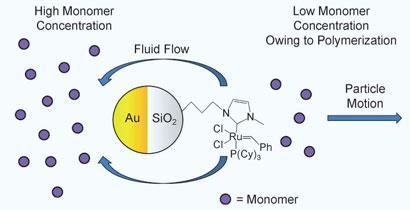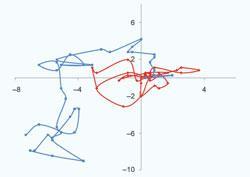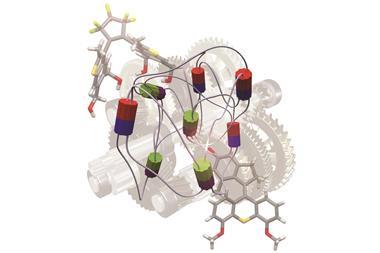A chemical spider uses a Grubbs' catalyst to spin its polymer web and power its movement
A chemical spider that spins a polymer thread using a simple catalyst could drive a nanomotor, according to researchers at Pennsylvania State University, US. Ayusman Sen and colleagues say that these nanomotors have potential applications in the deposition of polymers within the channels of microdevices for instance.
Until now, nanomotors have been powered by the catalytic conversion of small fuel molecules, which leads to a chemical gradient that propels the molecular assembly. However, for many applications this is not the ideal motoring method. Sen and colleagues knew, however, that a polymerisation process can drive some biological systems. The motion of Listeria, for instance, is driven by polymerisation of the protein actin. The team thought that the availability of a wide range of organometallic polymerisation catalysts might be useful in increasing the scope of catalytic reactions to power autonomous motion.

Although researchers at Rice University, Texas, independently suggested the possibility of polymerisation-powered motion1, the concept has not been demonstrated in the lab until now.

The Penn State team turned to the ring-opening metathesis polymerisation (ROMP) of norbornene using a simple Grubbs’ catalyst - a transition metal carbene complex - to demonstrate a polymerisation-powered nanomotor. They first prepared gold-silica Janus particles by coating 0.96?m silica particles asymmetrically with gold monolayers. They then chemically modified the silica side of the particles with the Grubbs’ catalyst.2
The particles were powered up by adding them to a solution of norbornene and consumption of the monomer was monitored using gas chromatography. The asymmetric particles immediately begin to spin out a polymer strand, as evidenced by scanning electron microscopy. The turnover rate is proportional to norbornene concentration, the team explains. Intriguingly, if there is a concentration gradient, the particles undergo chemotaxis, which the team observed using optical microscopy. The particles move up the chemical gradient, a phenomenon rarely witnessed outside biology. Addition of a catalytic inhibitor, ethyl vinyl ether, puts the brakes on the molecular motoring, the researchers adds.
The team also tested gold-silica Janus particles without the attached Grubbs’ catalyst as unpowered controls and found that these particles do not undergo directional diffusion.
James Tour, Chao Professor of Chemistry at Rice University, US, who suggested this approach to molecular motoring, says: ’This an elegant application and demonstration of polymerisation powered propulsion.’ He adds: ’The synthesis and demonstration is not simple, and the authors have done a terrific job.’
David Bradley
References
1. J Godoy, G Vives and J M Tour, ACS Nano, 2011, 5, 85 (DOI: 10.1021/nn102775q)
2. R A Pavlick et al, Angew. Chem. Int. Ed., 2011, DOI: 10.1002/ange.201103565







No comments yet